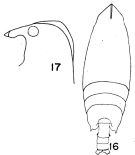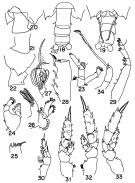|
|
 |
|
Calanoida ( Order ) |
|
|
|
Clausocalanoidea ( Superfamily ) |
|
|
|
Scolecitrichidae ( Family ) |
|
|
|
Scottocalanus ( Genus ) |
|
|
| |
Scottocalanus backusi Grice, 1969 (F) | |
| | | | | | | Ref.: | | | Grice, 1969 a (p.451, Descr.F, figs.F) |  issued from : G.D. Grice in Bull. mar. Sc., 1969, 19 (2). [p.447, Figs. 16-17]. Female (from G. of Mexico): 16, habitus (dorsal); 17, forehead (lateral). Nota: Cephalothorax about 3.9 times length of urosome. Head and 1st thoracic segment fused, 4th and 5th fused. Forehead with crest. Rostrum thick, 2-pointed.Urosome 4-segmented. Genital segment bearing on each side a conspicuous spine-like protrusion. Caudal rami about as long as wide. A1 exceed caudal rami by last 2 segments.
|
 issued from : G.D. Grice in Bull. mar. Sc., 1969, 19 (2). [p.448, Figs. 18-34]. Female: 18, urosome (dorsal); 19, idem (ventral), showing P5; 20, genital segment (lateral right obique view); 21, idem (lateral left obique view); 22, idem (lateral right side); 23, A2; 24, Md (mandibular palp); 25, Md (cutting edge of mandibular blade); 26, Mx1; 27, distal end of Mx2; 28, basal portion of Mxp; 29, distal portion of Mxp; 30, P1; 31, P2; 32, P3; 34, P5. Nota: Distal endopodal segment of Md with 2 rows of small spines.Mx1 with12 spines on 1st inner lobe, 2 setae on 2nd inner lobe, 3 setae on 3rd inner lobe; 5 setae on 2nd basal segment; 7 setae on endopod; 8 setae on exopod; 9 setae on 1st outer lobe. Distal end of Mx2 with vermiform and bulb-tipped sensory appendages.
| | | | | Compl. Ref.: | | | Roe, 1975 (p.313: Rem.); Park, 1983 (p.198, 199); Bradford & al., 1983 (p.116); Suarez-Morales & Gasca, 1998 a (p.111) | | | | NZ: | 1 | | |
|
Distribution map of Scottocalanus backusi by geographical zones
|
| | | | Loc: | | | Gulf of Mexico | | | | N: | 1 | | | | Lg.: | | | (225) F: 5,91-5,41; {F: 5,41-5,91} | | | | Rem.: | ? Cf. Scottocalanus thomasi.
For Roe (1975, p.313) the females sampled from Cape Verde Islands and identificated as S. thomasi agree with Grice’s (1969) description of S. backusi. The females of these two species apparently differ only in the structure of their genital segment where S. backusi has a pair of spine-like protrusions.
Sewell (1929) described the genital segment of S. thomasi as having << a finger-like backwardly directed projection near the posterior margin a little to the left of the middle line >> ;
Roe examined a female specimen of S. thomasi in the collections of the British Museum (Natural History), which was taken at ‘Investigator’ Station 670 and presumably identified by Sewell. It has 2 spine-like projections on its genital segment (as shown in Fig.9e, g). These projections are not always conspicuous, especially if they are bent back alongside the genital segment, and they can be easily overlooked. For this reason I think it probable that S. backusi and S. thomasi are conspecific. | | | Last update : 31/01/2015 | |
|
|
 Any use of this site for a publication will be mentioned with the following reference : Any use of this site for a publication will be mentioned with the following reference :
Razouls C., Desreumaux N., Kouwenberg J. and de Bovée F., 2005-2025. - Biodiversity of Marine Planktonic Copepods (morphology, geographical distribution and biological data). Sorbonne University, CNRS. Available at http://copepodes.obs-banyuls.fr/en [Accessed June 04, 2025] © copyright 2005-2025 Sorbonne University, CNRS
|
|
 |
 |





